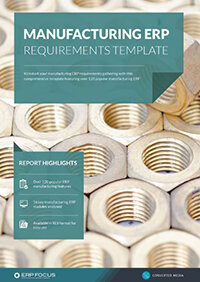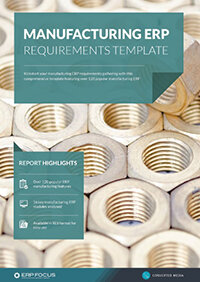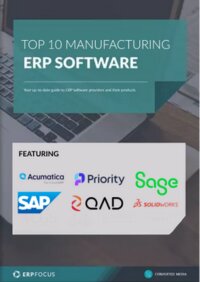Selecting a manufacturing ERP system
Companies are generally pretty good at selecting accounting systems, and so they should be because such systems have been around for over half a century. They are further helped in their endeavors by the fact that the principles of accounting have been in place for a very long time and, unless somebody invents triple-entry bookkeeping, are unlikely to change much in the future.
And accounting at, say, Boeing is not much different from accounting at Heinz, so system developers have had many years to build out the functionality of their offerings to the extent that most accounting systems do most of what most companies need. So the selection process usually focuses on things like the ability to cope with individual companies' account numbering structures, the ability to link to other systems, or the ability to handle differing tax systems in different countries.
But when we move from accounting systems to ERP systems, things start to go wrong, and when we get to manufacturing ERP systems, sub-optimal or failed implementations become common. A dissatisfaction rate for ERP systems overall is regularly reported as being greater than 70% and many of these are manufacturing systems.
Many articles have been written to discuss the reasons for this. Still, this one looks particularly at manufacturing ERP and ensuring that companies get what they need – ERP systems are not cheap, so companies need to get value for money. One problem that ERP systems have to cope with is that there are so many different types of manufacturing.
Taking the previous examples of Boeing and Heinz - although accounting might be similar at both, we can imagine that making Dreamliners and making ketchup are very different processes, requiring very different systems. Add into that equation that there are different kinds of manufacturing, from job shop to process, from batch to project, and it is apparent that it is asking a lot of a system, and the people implementing it, to cover all bases.
Just to confuse matters further, not everything sold as an ERP system is an ERP system. Many very good accounting systems have had a rudimentary buy/assemble/stock/sell functionality added (we can probably call these 'Accounting+' systems). These are perfectly adequate when companies have very simple manufacturing needs and do not consider an improvement in productivity, or a decrease in costs, to be worth the investment.
The following is a list of things that companies can expect to find in a full-functionality manufacturing ERP system. It is important to stress that most companies will not need everything on this list; for example, a process manufacturer probably doesn't need finite capacity scheduling, and a furniture manufacturer probably won't need batch traceability, so a particular system does not necessarily have to have everything on this list to be suitable for a particular company.
Nevertheless, if a company needs these things, they need to be available in the chosen system to obviate the need for expensive or inefficient workarounds and manual supporting systems:
- Master Production Schedule (MPS)
- Materials Requirements Planning (MRP)
- Finite Capacity Scheduling
- Bills of Material (BOMs)
- Routings
- Work Order Processing
- Work-in-Progress (WIP) Tracking
- Traceability
- Quality Management
- Maintenance
Master Production Schedule (MPS)
In many companies, production capacity and customer orders are extremely difficult to align because in any one week there can be either spare capacity or excess capacity, depending on customer orders. It generally doesn't make sense to pay production staff overtime one week and lay them off the next, so companies create an MPS (effectively an overall production plan) to smooth the load.
Having a formal MPS allows the production plan to be assessed and validated before purchase orders are raised for the necessary materials and when sales forecasts are included, it allows an 'available to promise' facility which, through scheduling capacity and materials in advance, allows delivery lead times to customers to be reduced.
Materials Requirements Planning (MRP)
When the production plan (MPS) has been agreed upon, MRP ensures that the necessary sub-assemblies and raw materials are ordered to support it. And if the plan changes, MRP can recommend changes to those orders to ensure that both shortages and excesses are minimized.
For MRP to work well, it needs several of the other things on this list, but it also needs MRP-specific data, such as batch sizing rules, replenishment lead times, and the ability to identify some stock on-hand as “non-nettable” (i.e. unusable) during its calculations.
Non-nettable stock includes stock that is quarantined or rejected, along with stock that is being reserved for particular jobs or customers.
Finite Capacity Scheduling
When a company has many interdependent work centers or machines, optimal scheduling of work can contribute markedly to throughput but also work-in-progress reduction. In some industries, such as plastics and foodstuffs, there is a preferred sequence when processing multiple jobs.
For example; in the plastics industries it is common to move along the color spectrum from clear to black before having to do a complete clean-down and starting again, and in foodstuffs, it is common to move from mild flavors to strong. Another example here would be that moving from vanilla ice cream to chocolate is easier than from chocolate to vanilla.
A company's production planners will know these rules but their task is not easy because even 6 jobs passing through one machine can be processed in (6x5x4x3x2x1) = 720 different sequences. When machines are interdependent, the rules can get very complex and, as an indication of this, one well-known capacity scheduler tests 250,000 different iterations before selecting the best.
So a good FCS system can make a real difference and also has the considerably added advantage of allowing companies to make more accurate and reliable delivery promises to their customers. And that is something that they will appreciate.
Bills of Material (BOMs)
Bills of material list all components and materials that go into a product. But they do more than that because properly structured, they show how the product goes together; i.e. the relationships between raw materials and sub-assemblies, and sub-assemblies and end products.
Many companies have products with multiple levels of sub-assembly and 6-8 is not uncommon. The structure of the bill allows requirements for materials and sub-assemblies to be time-phased, or offset; thus reducing WIP quantity and value. Some 'Accounting+' systems claim BOM functionality but their BOMs are frequently only parts lists, without the structure that proper BOMs offer.
All that such systems can do is recommend that all of the items on the parts list (also known as a 'single level bill of material') are available for when production is due to commence. That might not be a problem when manufacturing ketchup but Mr. Boeing is unlikely to be happy when all of the components for building a Dreamliner turn up at the factory on day one of assembly.
Full-function manufacturing ERP systems also have to be able to cope with situations where manufacturers have alternative components that they can use when circumstances dictate. Sometimes this means holding these alternatives at item level on the BOM but sometimes it can be preferable to have complete alternative bills.
Routings
As the BOM specifies what materials go into making a particular item, so the routing specifies the machines, labor, and tooling required, (in fact, some systems combine the two into a 'bill of resource'). Routings allow the labor and machine content of manufacture to be costed and, when linked to work orders, allow those to be planned by the FCS system (see above) and tracked by the WIP tracking system (see below).
As with BOMs, ERP systems should allow alternative routings for each item to be held and substitutes when necessary (e.g. when a job normally processed on a CNC machine has to be moved to a lathe because of capacity restraints).
Work Order Processing
Work orders are more than just documents issued to the shop floor to tell them what to make, and when. They have the items' BOM and routing copied to them and that facilitates several things:
- The job can be planned by the FCS system.
- The job can be costed and, in a standard costing environment, variances can be identified and posted to suitable variance accounts (this also allows true product profitability to be determined).
- A detailed pick list can be produced to move materials and tools to the production area as and when (and only when) required.
- Realistic work schedules can be published for every department.
Work-in-Progress (WIP) Tracking
Many companies only want to know the value of their WIP. They are process industries or make items on a production line, so they only need to know when jobs start and finish. On a fixed-speed production line, as soon as a job starts they know when it will finish and, from a WIP valuation point of view, every job on the line will be an average of 50% completed.
But for others, especially those in complex manufacturing environments where jobs go from one separate work center to another, knowing exactly what stage a particular job is can be crucial. A WIP tracking option allows progress to be recorded and reported and, to reduce admin overhead, some systems allow progress at 'milestone' points only, with intermediate activities being assumed to have been completed (as indeed they must have been).
Traceability
In many industries such as foodstuffs and aerospace, it is mandatory to be able not only to track end products but to know the source of every ingredient or component used in the manufacture of a particular batch or item. Further, if only part of a batch was used, it is necessary to be able to identify where the rest of the batch went, all the way through to the end product batch or serial number.
Full functionality ERP systems offer this bi-directional traceability without recourse to bulky paper trails.
Quality Management
Closely aligned with traceability, ERP systems allow quality inspection data to be held for selected items. When a positive quality release is required, systems can prevent uninspected items or batches from being allocated or selected, although some can be set to just trigger warnings.
Beyond that, when items are traceable, those that present quality problems can be traced back to the source so that, over time, underperforming suppliers can be identified. One option then is to enforce stricter checks on goods from such companies until such times as the problems are resolved.
Maintenance
Some companies repair plant when it breaks down, whilst others do preventive maintenance. Either way, ERP can help. Raising a work order for maintenance allows such work to be properly costed so that companies can see how much particular items of plant are costing them.
They can also analyze these work orders to see if some machines are less reliable than others, whether they break down more often whilst processing particular jobs, or on some shifts more often than others. They can also be fed into the capacity scheduling system so that it knows not to plan production when particular machines are not available.
And of course, spare stock can be controlled by the inventory control system and ordered through the purchasing system.
Clearly, as other articles on this website about cost reduction and increased profitability have demonstrated, ERP systems have much to contribute. But if companies choose what we have referred to as Accounting+ systems (systems that don't offer the above functionality) they cannot expect to gain all of the advantages that ERP offers.
It is for individual companies to decide how important the manufacturing cost reduction and improved customer service obtainable from the functionality explored in this blog are to them.
Free white paper

Manufacturing ERP requirements template
Over 120 critical manufacturing ERP features in one downloadable spreadsheet

Featured white papers
Related articles
-

ERP for make-to-order manufacturing
How can ERP help your make-to-order manufacturing business thrive?
-

CMMC Compliance: What Aerospace and Defense Manufacturers Need to Know
Key insights on CMMC compliance, deadlines, and securing DoD contracts with CMMC 2.0 certificatio...
-

Shop floor management: 4 ways ERP can improve efficiency
Learn about the shop floor efficiencies that can be realized through the implementation of manufa...




